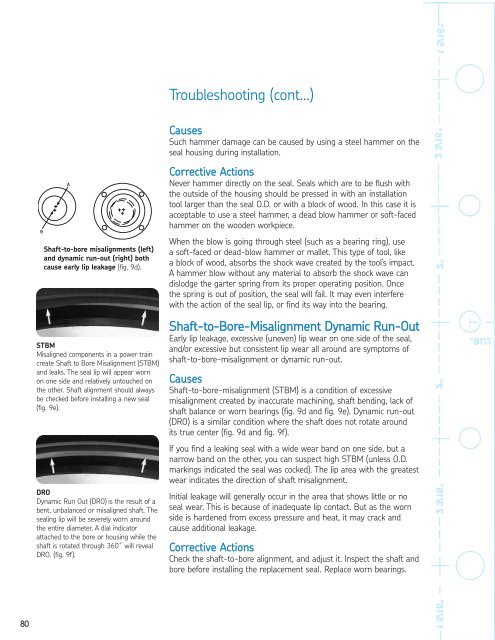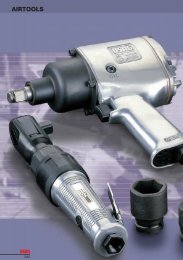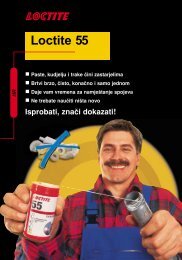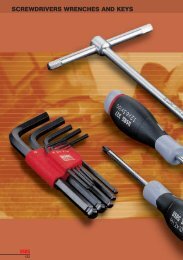Industrial seal self study guide - SKF.com
Industrial seal self study guide - SKF.com
Industrial seal self study guide - SKF.com
Create successful ePaper yourself
Turn your PDF publications into a flip-book with our unique Google optimized e-Paper software.
Troubleshooting (cont...)<br />
Causes<br />
Such hammer damage can be caused by using a steel hammer on the<br />
<strong>seal</strong> housing during installation.<br />
B<br />
A<br />
Shaft-to-bore misalignments (left)<br />
and dynamic run-out (right) both<br />
cause early lip leakage (fig. 9d).<br />
STBM<br />
Misaligned <strong>com</strong>ponents in a power train<br />
create Shaft to Bore Misalignment (STBM)<br />
and leaks. The <strong>seal</strong> lip will appear worn<br />
on one side and relatively untouched on<br />
the other. Shaft alignment should always<br />
be checked before installing a new <strong>seal</strong><br />
(fig. 9e).<br />
DRO<br />
Dynamic Run Out (DRO) is the result of a<br />
bent, unbalanced or misaligned shaft. The<br />
<strong>seal</strong>ing lip will be severely worn around<br />
the entire diameter. A dial indicator<br />
attached to the bore or housing while the<br />
shaft is rotated through 360˚ will reveal<br />
DRO. (fig. 9f).<br />
Corrective Actions<br />
Never hammer directly on the <strong>seal</strong>. Seals which are to be flush with<br />
the outside of the housing should be pressed in with an installation<br />
tool larger than the <strong>seal</strong> O.D. or with a block of wood. In this case it is<br />
acceptable to use a steel hammer, a dead blow hammer or soft-faced<br />
hammer on the wooden workpiece.<br />
When the blow is going through steel (such as a bearing ring), use<br />
a soft-faced or dead-blow hammer or mallet. This type of tool, like<br />
a block of wood, absorbs the shock wave created by the tool’s impact.<br />
A hammer blow without any material to absorb the shock wave can<br />
dislodge the garter spring from its proper operating position. Once<br />
the spring is out of position, the <strong>seal</strong> will fail. It may even interfere<br />
with the action of the <strong>seal</strong> lip, or find its way into the bearing.<br />
Shaft-to-Bore-Misalignment Dynamic Run-Out<br />
Early lip leakage, excessive (uneven) lip wear on one side of the <strong>seal</strong>,<br />
and/or excessive but consistent lip wear all around are symptoms of<br />
shaft-to-bore-misalignment or dynamic run-out.<br />
Causes<br />
Shaft-to-bore-misalignment (STBM) is a condition of excessive<br />
misalignment created by inaccurate machining, shaft bending, lack of<br />
shaft balance or worn bearings (fig. 9d and fig. 9e). Dynamic run-out<br />
(DRO) is a similar condition where the shaft does not rotate around<br />
its true center (fig. 9d and fig. 9f).<br />
If you find a leaking <strong>seal</strong> with a wide wear band on one side, but a<br />
narrow band on the other, you can suspect high STBM (unless O.D.<br />
markings indicated the <strong>seal</strong> was cocked). The lip area with the greatest<br />
wear indicates the direction of shaft misalignment.<br />
Initial leakage will generally occur in the area that shows little or no<br />
<strong>seal</strong> wear. This is because of inadequate lip contact. But as the worn<br />
side is hardened from excess pressure and heat, it may crack and<br />
cause additional leakage.<br />
Corrective Actions<br />
Check the shaft-to-bore alignment, and adjust it. Inspect the shaft and<br />
bore before installing the replacement <strong>seal</strong>. Replace worn bearings.<br />
80







